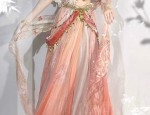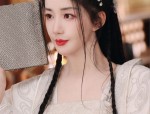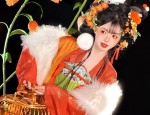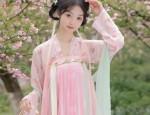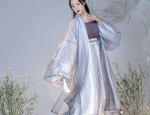Designing the Modern Qipao:Embracing the Classic Charm of the Cheongsam with a Modern Twist
In the realm of fashion, traditional attire often holds a special place in the hearts of many, embodying a sense of cultural heritage and historical significance. The cheongsam, also known as the qipao in Chinese culture, is one such piece of clothing that encapsulates the essence of elegance and grace. However, to make this traditional garment relevant in modern times, designers must strike a balance between respecting its rich history and injecting contemporary elements that appeal to a modern audience.

The design process of a modern qipao begins with an appreciation for its historical significance and the craftsmanship that goes into its creation. The traditional qipao was designed to accentuate the female form, with intricate details and patterns that were not only decorative but also symbolic of status and culture. As designers revisit this classic piece, they must understand the significance of these details and patterns, which often hold deep cultural meanings.
To make the qipao more appealing to a modern audience, designers often experiment with different materials and cuts. For instance, instead of using traditional silk or cotton, designers may experiment with different fabrics like lightweight chiffon or luxurious velvet, depending on the occasion and the desired aesthetic. The cuts are also tailored to fit modern body types, ensuring that the qipao not only looks beautiful but is also comfortable to wear.
Another aspect that designers focus on is the fusion of traditional elements with modern designs. This can be achieved through the use of contemporary patterns and colors, which are then integrated with traditional motifs and designs. For instance, instead of using traditional floral patterns, designers may opt for abstract patterns or geometric shapes that are more in line with modern aesthetics. This fusion not only gives the qipao a contemporary look but also preserves its traditional essence.
Moreover, designers also play around with the length and shape of the qipao to create new styles that are more suitable for different occasions. Shortened versions of the qipao, often referred to as “modern cheongsam tops” or “modern qipao tops,” are becoming increasingly popular among younger women who want to embrace the charm of the traditional cheongsam without conforming to its traditional length. These shortened versions not only show off the wearer’s figure but also allow for more flexibility in movement, making them perfect for modern events and parties.
In addition to these changes in length and material, designers are also exploring ways to incorporate contemporary fashion trends into the qipao. For instance, they may experiment with different necklines, such as off-the-shoulder or one-sided necklines, or add contemporary details like sequins or beads to create a more glamorous look. These additions not only make the qipao more appealing to a modern audience but also help to revive its popularity in modern fashion circles.
In conclusion, designing a modern qipao is about respecting its rich history and cultural significance while incorporating contemporary elements that make it relevant in modern times. It’s about taking a traditional garment and transforming it into something that not only looks beautiful but also reflects the wearer’s personality and style. Through careful consideration of material, cuts, patterns, and fusion of traditional and modern elements, designers can create a qipao that embodies both classic charm and contemporary elegance. Such designs not only help to revive the popularity of this traditional garment but also contribute to the evolution of fashion in general.

 Previous Post
Previous Post

